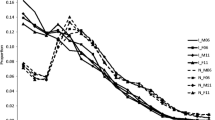Abstract
The ecological theory of migration asserts that change in sustenance organization, to the extent that it produces changes in the opportunities for living, necessitates a change in population size. Migration may thus be viewed as a demographic response to the population’s need to reestablish a balance between its size and sustenance organization, thus attaining its best possible living standard. However, the levels of net in- or out-migration needed to restore the balance should be affected by the degree of positive or negative growth of the indigenous labor force population. We thus test the hypothesis that changes in opportunities for living will be balanced by net changes in the number of persons in the labor force, where this is a function of both indigenous labor supply and net migration.
Similar content being viewed by others
References
Bowles, G. K. 1976. Potential Change in the Labor Force in the 1970-80 Decade for Metropolitan and Nonmetropolitan Counties in the United States. Phylon 37:263–269.
Bradshaw, B. S. 1976. Potential Labor Force Supply, Replacement, and Migration of Mexican-American and Other Males in the Texas-Mexico Border Region. International Migration Review 10:2945.
Frisbie, W. Parker, and D. L. Poston, Jr. 1975. Components of Sustenance Organization and Nonmetropolitan Population Change; a Human Ecological Investigation. American Sociological Review 40:773–784.
—, and D. L. Poston, Jr. 1976. The Structure of Sustenance Organization and Population Change in Nonmetropolitan America. Rural Sociology 41:354–370.
—, and D. L. Poston, Jr. 1978. Sustenance Organization and Population Redistribution in Nonmetropolitan America. Iowa City: Iowa Urban Community Research Center, University of Iowa Press.
Hawley, Amos. 1950. Human Ecology. New York: Ronald Press.
Morrison, Peter A., and D. A. Relies. 1975. Recent Research Insights Into Local Migration Flows. The Rand Paper Series, P-5379. Santa Monica, Calif.: The Rand Corporation.
Pursell, D. E. 1972. Determinants of Male Labor Mobility. Demography 9:257–261.
Sly, D. F. 1972. Migration and the Ecological Complex. American Sociological Review 37:615–628.
—, and D. Tayman. 1977. The Ecological Approach to Migration Reexamined. American Sociological Review 42:783–795.
Stinner, W. R., and G. F. Dejong. 1969. Southern Negro Migration: Social and Economic Components of an Ecological Model. Demography 6:455–473.
Author information
Authors and Affiliations
Rights and permissions
About this article
Cite this article
Poston, D.L., White, R. Indigenous labor supply, sustenance organization, and population redistribution in nonmetropolitan america: An extension of the ecological theory of migration. Demography 15, 637–641 (1978). https://doi.org/10.2307/2061213
Issue Date:
DOI: https://doi.org/10.2307/2061213




